Candlesiands. Shallow knee carving—here in the form of fleur-de-lis, V-shaped lambrequin, and acanthus leaf—combined with a turned urn and Doric or Tuscan columnar shaft relate Figure 26 to other New York screens, stands, and tables.
A heavy disc separating an urn or baluster shape from the base of the shaft is frequently seen on New York stands. The platform and squat posts supporting the top of Figure 27, called a birdcage, permitted it to revolve as well as tilt up and down. It was used in any locale where a customer would pay the extra cost required by adding this feature to a stand. New York tripod-base furniture of this period might have claw-and-ball, paw, and carved or plain dolphin feet (Figs. 25-27).
The carved C-scrolls circling its top (Fig. 27) contrast with the plain, dished top of Figure 26.
Leaf carving and fluting on baluster – or vase-shaped shafts occur on other New York tables (PI. IV; Fig.
34). Fig. 26: mahogany; 1760-75; H26%" (67.6 cm), Diam 20Vi" (52.1 cm); acc. no. G64.663. Fig. 27: mahogany; 1760-75; H 28 Vi" (72.4 cm), Diam 21%"
(55.2 cm); acc. no. G58.1778.
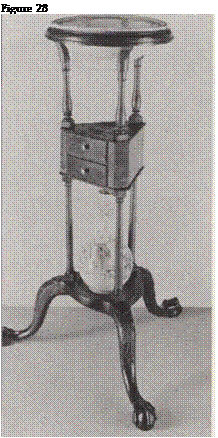
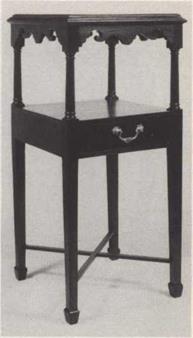
Figures 28 and 29. Basin, or Washstands. Figure 28 was once thought to be of Massachusetts origin,8 but its tulip drawer linings—a wood not used in Massachusetts furniture of this period—shallow C-scroll and acanthus-leaf carving on its knees, claw-and-ball feet, and Doric columns supporting a shelf of drawers are attributes of other New York furniture.
Except for its secondary woods, Figure 29 provides few clues to its origin.
Doric or Tuscan columns support a top shelf and the drawer is fashioned of red gum, a wood frequently used for hidden furniture construction by New York cabinetmakers. Fig. 28: mahogany, tulip; 1770-80; H 3I5/e"
(80.3 cm); асе. no. C58.2269. Fig.
29: mahogany, red gum; 1780-95; H 31Vi" (79.4 cm); асе. no. C61.139.
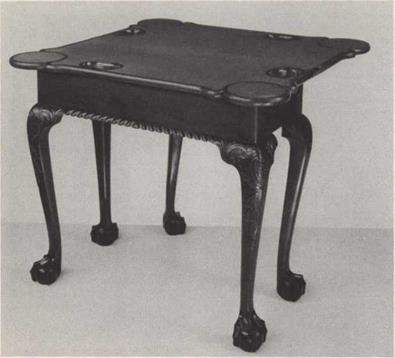

Figure 30. Gaming Table. Card and gaming tables, often made in pairs, supplied playing surfaces for dicing, backgammon, chess, and many card games. As with other gaming tables, this one has a baize-covered top, pockets for coins or counters, and insets for candlesticks. Five legs; gadroon – carved skirt; square or blocklike claw-and-ball feet; asymmetrical C-scroll, leaf, ruffle, and punchwork carving on the front knees (Fig. 30a) are all features this table shares with related examples (cf. n. 9). Its straight frame, circular candlestick insets, and smaller size are unusual (Figs. 31, 32). Fig. 30: mahogany, red gum, white oak, white pine, tulip; 1765-80; H (open) 27" (68.6 cm); acc. no. G51.73.
Figure 30a
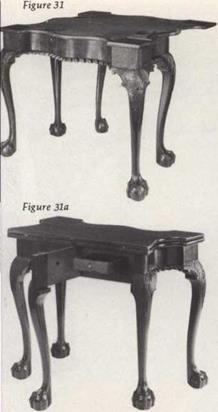 Figures 31 and 32. Gaming Tables. Fivelegged card, or gaming, tables with bold, sinuous, serpentine-curved frames; gadrooned-carved front skirts; square corner insets for candlesticks; C-scroll, leaf, and ruffle carving on their knees; and sturdy claw-and-ball feet were the most successful furniture form made by New York cabinetmakers in the Chippendale period. A secret drawer, concealed behind the flying rail of the swing leg (Fig. 31a), was customary on New York tables of this type. Occasionally, the practice was also followed in Philadelphia (Fig. 99). Unlike Figure 30, these tables have partial carving decorating their rear knee brackets or knees. Stylistic and technical differences in carving on knees and skirt are obvious when these tables are compared. Figure 31 is described by Morrison Heckscher as a Van Rensselaer type, and Figure 32 is closely related to a Beekman family table owned by The New-York Historical Society.9 Fig. 31: mahogany, American beech, cherry, black gum, white pine; 1760-75;
Figures 31 and 32. Gaming Tables. Fivelegged card, or gaming, tables with bold, sinuous, serpentine-curved frames; gadrooned-carved front skirts; square corner insets for candlesticks; C-scroll, leaf, and ruffle carving on their knees; and sturdy claw-and-ball feet were the most successful furniture form made by New York cabinetmakers in the Chippendale period. A secret drawer, concealed behind the flying rail of the swing leg (Fig. 31a), was customary on New York tables of this type. Occasionally, the practice was also followed in Philadelphia (Fig. 99). Unlike Figure 30, these tables have partial carving decorating their rear knee brackets or knees. Stylistic and technical differences in carving on knees and skirt are obvious when these tables are compared. Figure 31 is described by Morrison Heckscher as a Van Rensselaer type, and Figure 32 is closely related to a Beekman family table owned by The New-York Historical Society.9 Fig. 31: mahogany, American beech, cherry, black gum, white pine; 1760-75;
H 29’U" (74.3 cm); acc. no. G59.2843.
Fig’. 32: mahogany, white pine, tulip;
1770-80; H 27’h" (69.7 cm); acc. no.
G58.1791.
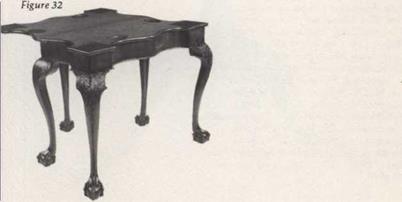
Figure 33. Side Table. The clean, simple lines of Chinese furniture design dovetailed with the classical taste that remained strong throughout this period. Figure 33 is a New York cabinetmaker’s version of a "Sideboard Table" that appeared in all three editions of the Director (PI. LVI, 1762 ed.). Its heavy legs, softened by molding, were needed to support the weight of a marble top. The New York Mercury (Dec. 28,1767) offered "choice Marble Slabs, for Side-Tables." In 1760, Mrs. fames Alexander of New York City bequeathed to her daughter, "the marble tables that now are in the Dining Room."10 Fig. 33: mahogany, mahogany veneer on cherry frame, tulip; 1760-75; 1Л/ 58" (147.3 cm); acc. no. G60.1070.
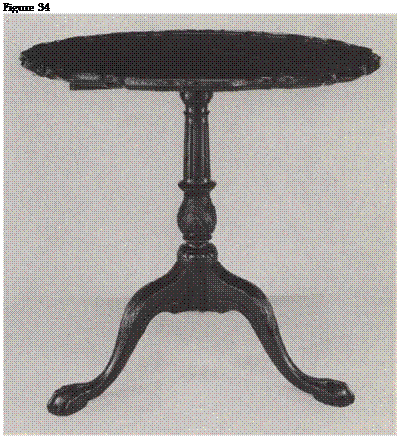
Figure 34. Tea Table. This table has been described as probably of Massachusetts origin. u The leaf-carved vase of its shaft, fluted pillar, and carving on the edge of its scalloped top relate it to a New York example (PI. IV), and its paw feet are similar to a New York candlestand (Tig. 26). Without secondary woods and other documentation, however, it can only be stated that this tea table was probably made in New York. Fig. 34: mahogany; 1765-80; H 28V (72.1 cm), Diam 29V (75.6 cm); асе. no. C57.513.

Figures 35, 36, and 37.
Tea and China Tables. Within the tenets of accepted behavior, practice, and economics in the Chippendale period craftsman and patron had a tremendous opportunity for choice. These tea tables provide an excellent illustration of that fact.
A molded-edge tray (Fig.
35) or a Gothic-arched pierced gallery (Fig. 36) prevent tea equipage from being accidentally swept from their tops. Another (Fig. 37), has an unprotected top like a tea board supported on a frame. Its undulating, stepped, molded edge invites catastrophe. Carved gadrooning decorates the skirts of all the tables, but one example is of very high quality (Figs. 37, 37a).
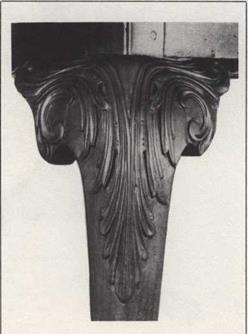 Figure 36a
Figure 36a
The leaf carving on two examples is similar (Fig.
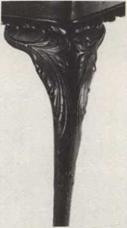 36a), but on one (Fig. 37a) the carving seems to flow from a branch or twig and ends in fleur-de-lis. Sturdy New York-type claw-and-ball feet support two examples while the third (Figs. 37b, 37c) has a foot that is not square and has well-articulated carved claws (Fig. 5a). The tables are finished on all four sides indicating that they were to be placed away from a wall. Although the type illustrated by Figure 36 is called a "China Table" by Chippendale, he did indicate that they might also be used as tea tables. Fig. 35: mahogany, white pine; 1765-80, H 27V«" (69.2 cm); gift of Lammot du Pont Copeland; acc. no. G53.152.2. Fig. 36: mahogany, white pine; 1765-80; H28Vi~(71.7cm); acc. no. G52.18. Fig. 37: mahogany, cherry; 1760-80; H 27" (68.6 cm); owned originally by Halstead family of Milton Neck or Rye, N. У.; acc. no. G59.2840.
36a), but on one (Fig. 37a) the carving seems to flow from a branch or twig and ends in fleur-de-lis. Sturdy New York-type claw-and-ball feet support two examples while the third (Figs. 37b, 37c) has a foot that is not square and has well-articulated carved claws (Fig. 5a). The tables are finished on all four sides indicating that they were to be placed away from a wall. Although the type illustrated by Figure 36 is called a "China Table" by Chippendale, he did indicate that they might also be used as tea tables. Fig. 35: mahogany, white pine; 1765-80, H 27V«" (69.2 cm); gift of Lammot du Pont Copeland; acc. no. G53.152.2. Fig. 36: mahogany, white pine; 1765-80; H28Vi~(71.7cm); acc. no. G52.18. Fig. 37: mahogany, cherry; 1760-80; H 27" (68.6 cm); owned originally by Halstead family of Milton Neck or Rye, N. У.; acc. no. G59.2840.
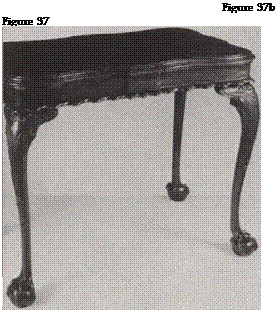 |
|
|




